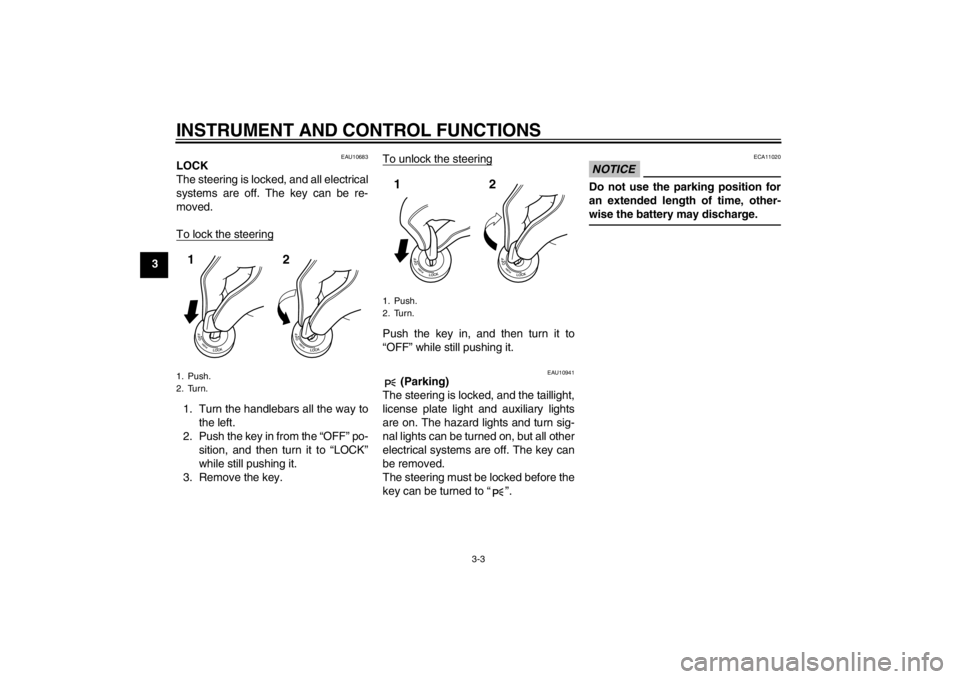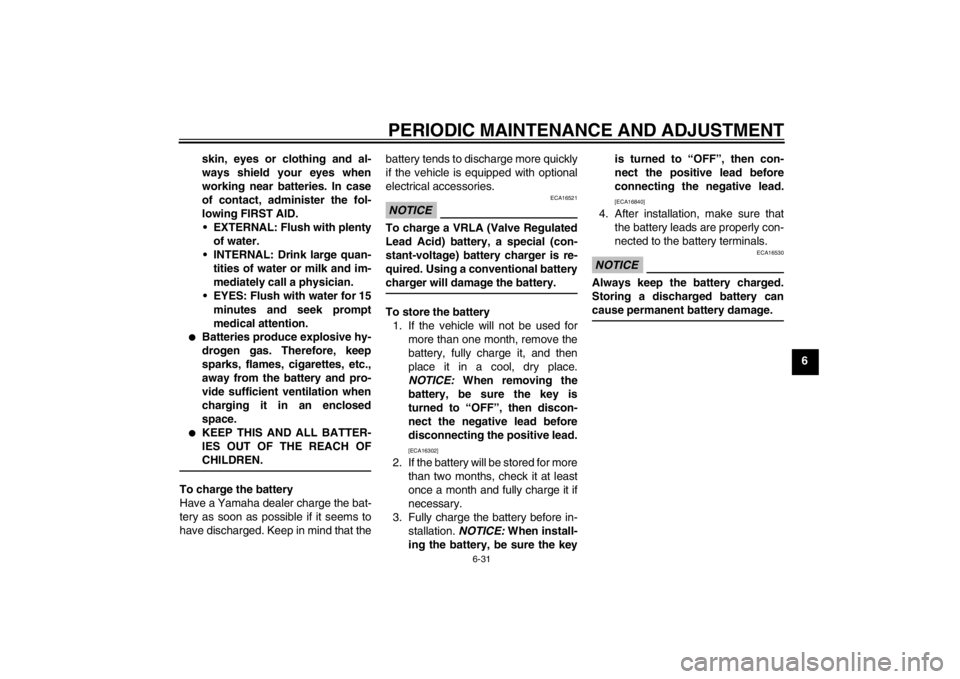2012 YAMAHA FZ1-N battery
[x] Cancel search: batteryPage 7 of 106

TABLE OF CONTENTS
Checking and lubricating the sidestand ............................. 6-29
Checking the front fork ................. 6-29
Checking the steering ................... 6-30
Checking the wheel bearings ....... 6-30
Battery .......................................... 6-30
Replacing the fuses ...................... 6-32
Replacing the headlight bulb ........ 6-34
Replacing the tail/brake light bulb ........................................... 6-35
Replacing a turn signal light
bulb ........................................... 6-36
Replacing the license plate light bulb ........................................... 6-36
Replacing an auxiliary light bulb ... 6-37
Supporting the motorcycle ............ 6-38
Front wheel (for non-ABS models) ............... 6-38
Rear wheel (for non-ABS models) ............... 6-40
Troubleshooting ............................ 6-41
Troubleshooting charts ................. 6-43
MOTORCYCLE CARE AND
STORAGE .......................................... 7-1
Matte color caution ......................... 7-1
Care ................................................ 7-1
Storage ...........................................7-3 SPECIFICATIONS
............................ 8-1
CONSUMER INFORMATION ............ 9-1
Identification numbers .................... 9-1
U1ECE1E0.book Page 2 Monday, August 8, 2011 11:52 AM
Page 14 of 106

DESCRIPTION
2-2
2
EAU10420
Right view
1,2
3
4
5
6
79
10
11
12
2
8
1. Owner’s tool kit (page 6-2)
2. Luggage strap holder (page 3-25)
3. Rider seat lock lever (page 3-19)
4. Fuse box (page 6-32)
5. Battery (page 6-30)
6. Rear brake fluid reservoir (page 6-23)
7. Engine oil filler cap (page 6-10)
8. Front fork rebound damping force adjusting screw (page 3-21)9. Engine oil level check window (page 6-10)
10.Brake pedal (page 3-15)
11.Coolant reservoir (page 6-13)
12.Rear brake light switch (page 6-22)U1ECE1E0.book Page 2 Monday, August 8, 2011 11:52 AM
Page 18 of 106

INSTRUMENT AND CONTROL FUNCTIONS
3-3
3
EAU10683
LOCK
The steering is locked, and all electrical
systems are off. The key can be re-
moved.
To lock the steering1. Turn the handlebars all the way tothe left.
2. Push the key in from the “OFF” po- sition, and then turn it to “LOCK”
while still pushing it.
3. Remove the key. To unlock the steering
Push the key in, and then turn it to
“OFF” while still pushing it.
EAU10941
(Parking)
The steering is locked, and the taillight,
license plate light and auxiliary lights
are on. The hazard lights and turn sig-
nal lights can be turned on, but all other
electrical systems are off. The key can
be removed.
The steering must be locked before the
key can be turned to “ ”.
NOTICE
ECA11020
Do not use the parking position for
an extended length of time, other-
wise the battery may discharge.
1. Push.
2. Turn.12
1. Push.
2. Turn.12
U1ECE1E0.book Page 3 Monday, August 8, 2011 11:52 AM
Page 80 of 106

PERIODIC MAINTENANCE AND ADJUSTMENT
6-30
6
EAU23283
Checking the steering Worn or loose steering bearings may
cause danger. Therefore, the operation
of the steering must be checked as fol-
lows at the intervals specified in the pe-
riodic maintenance and lubrication
chart.1. Place a stand under the engine to raise the front wheel off the
ground. (See page 6-38 for more
information.) WARNING! To
avoid injury, securely support
the vehicle so there is no danger
of it falling over.
[EWA10751]
2. Hold the lower ends of the front fork legs and try to move them for-
ward and backward. If any free
play can be felt, have a Yamaha
dealer check or repair the steering.
EAU23291
Checking the wheel bearings The front and rear wheel bearings must
be checked at the intervals specified in
the periodic maintenance and lubrica-
tion chart. If there is play in the wheel
hub or if the wheel does not turn
smoothly, have a Yamaha dealer check
the wheel bearings.
EAU50210
Battery The battery is located under the rider
seat. (See page 3-19.)
This model is equipped with a VRLA
(Valve Regulated Lead Acid) battery.
There is no need to check the electro-
lyte or to add distilled water. However,
the battery lead connections need to be
checked and, if necessary, tightened.
WARNING
EWA10760
●
Electrolyte is poisonous and
dangerous since it contains sul-
furic acid, which causes severe
burns. Avoid any contact with
1. Positive battery lead (red)
2. Negative battery lead (black)
3. Battery
U1ECE1E0.book Page 30 Monday, August 8, 2011 11:52 AM
Page 81 of 106

PERIODIC MAINTENANCE AND ADJUSTMENT
6-31
6
skin, eyes or clothing and al-
ways shield your eyes when
working near batteries. In case
of contact, administer the fol-
lowing FIRST AID.
EXTERNAL: Flush with plenty of water.
INTERNAL: Drink large quan- tities of water or milk and im-
mediately call a physician.
EYES: Flush with water for 15 minutes and seek prompt
medical attention.
●
Batteries produce explosive hy-
drogen gas. Therefore, keep
sparks, flames, cigarettes, etc.,
away from the battery and pro-
vide sufficient ventilation when
charging it in an enclosed
space.
●
KEEP THIS AND ALL BATTER-
IES OUT OF THE REACH OF
CHILDREN.
To charge the battery
Have a Yamaha dealer charge the bat-
tery as soon as possible if it seems to
have discharged. Keep in mind that the battery tends to discharge more quickly
if the vehicle is equipped with optional
electrical accessories.
NOTICE
ECA16521
To charge a VRLA (Valve Regulated
Lead Acid) battery, a special (con-
stant-voltage) battery charger is re-
quired. Using a conventional battery
charger will damage the battery.To store the battery
1. If the vehicle will not be used for more than one month, remove the
battery, fully charge it, and then
place it in a cool, dry place.
NOTICE: When removing the
battery, be sure the key is
turned to “OFF”, then discon-
nect the negative lead before
disconnecting the positive lead.
[ECA16302]
2. If the battery will be stored for more than two months, check it at least
once a month and fully charge it if
necessary.
3. Fully charge the battery before in- stallation. NOTICE: When install-
ing the battery, be sure the key is turned to “OFF”, then con-
nect the positive lead before
connecting the negative lead.
[ECA16840]
4. After installation, make sure that
the battery leads are properly con-
nected to the battery terminals.NOTICE
ECA16530
Always keep the battery charged.
Storing a discharged battery can
cause permanent battery damage.
U1ECE1E0.book Page 31 Monday, August 8, 2011 11:52 AM
Page 83 of 106

PERIODIC MAINTENANCE AND ADJUSTMENT
6-33
6
FZ1-NA
If a fuse is blown, replace it as follows.
TIPInclude steps 2, 3, 7 and 8 only for the
fuel injection system fuse.1. Turn the key to “OFF” and turn off
the electrical circuit in question. 2. Unhook the battery band, and then
remove the battery cover.
3. Remove the starter relay cover by pulling it upward. 4. Remove the blown fuse, and then
install a new fuse of the specified
amperage. WARNING! Do not
use a fuse of a higher amperage
rating than recommended to
avoid causing extensive dam-
age to the electrical system and
possibly a fire.
[EWA15131]
1. Ignition fuse
2. Signaling system fuse
3. Taillight fuse
4. Backup fuse (for clock and immobilizer sys- tem)
5. Right radiator fan fuse
6. Left radiator fan fuse
7. Spare fuse
8. ABS motor spare fuse
9. ABS control unit fuse
10.Headlight fuse
11.ABS motor fuse
1. Battery band
2. Battery cover
1. Starter relay cover
2. Fuel injection system fuse
3. Fuel injection system spare fuse
2
1
3
Specified fuses: Main fuse: 50.0 A
Headlight fuse:
15.0 A
Signaling system fuse: 10.0 A
Ignition fuse: 15.0 A
Fuel injection system fuse:
15.0 A
Taillight fuse: 10.0 A
Radiator fan fuse: 10.0 A × 2
Backup fuse:
10.0 A
ABS control unit fuse: FZ1-NA 10.0 A
ABS motor fuse: FZ1-NA 30.0 A
U1ECE1E0.book Page 33 Monday, August 8, 2011 11:52 AM
Page 84 of 106

PERIODIC MAINTENANCE AND ADJUSTMENT
6-34
65. Turn the key to “ON” and turn on
the electrical circuit in question to
check if the device operates.
6. If the fuse immediately blows again, have a Yamaha dealer
check the electrical system.
7. Install the starter relay cover.
8. Install the battery cover, and then hook the battery band onto the
holder.
EAU34385
Replacing the headlight bulb This model is equipped with a halogen
bulb headlight. If the headlight bulb
burns out, replace it as follows.NOTICE
ECA10650
Take care not to damage the follow-
ing parts:●
Headlight bulb
Do not touch the glass part of
the headlight bulb to keep it free
from oil, otherwise the transpar-
ency of the glass, the luminosity
of the bulb, and the bulb life will
be adversely affected. Thor-
oughly clean off any dirt and fin-
gerprints on the headlight bulb
using a cloth moistened with al-
cohol or thinner.
●
Headlight lens
Do not affix any type of tinted
film or stickers to the headlight
lens.
Do not use a headlight bulb of a
wattage higher than specified.
1. Remove the headlight unit by re-moving the bolts on each side.
2. Disconnect the headlight coupler, and then remove the headlight
bulb cover.1. Do not touch the glass part of the bulb.
1. Bolt
U1ECE1E0.book Page 34 Monday, August 8, 2011 11:52 AM
Page 93 of 106

PERIODIC MAINTENANCE AND ADJUSTMENT
6-43
6
EAU42503
Troubleshooting charts Starting problems or poor engine performance
Check the fuel level in
the fuel tank.1. Fuel
There is enough fuel.There is no fuel.
Check the compression.
Supply fuel.
The engine does not start.
Check the compression.
Operate the electric starter.2. Compression
There is compression.
There is no compression.
Check the ignition. Have a Yamaha dealer
check the vehicle.
Remove the spark plugs
and check the electrodes.3. Ignition
Wipe off with a dry cloth and correct the
spark plug gaps, or replace the spark plugs.
Have a Yamaha dealer check the vehicle.
The engine does not start.
Have a Yamaha dealer
check the vehicle.
The engine does not start.
Check the battery.
Operate the electric starter.4. Battery
The engine turns over
quickly.
The engine turns over
slowly.
The battery is good.Check the battery lead connections,
and have a Yamaha dealer charge
the battery if necessary.
DryWet
Operate the electric starter.
U1ECE1E0.book Page 43 Monday, August 8, 2011 11:52 AM